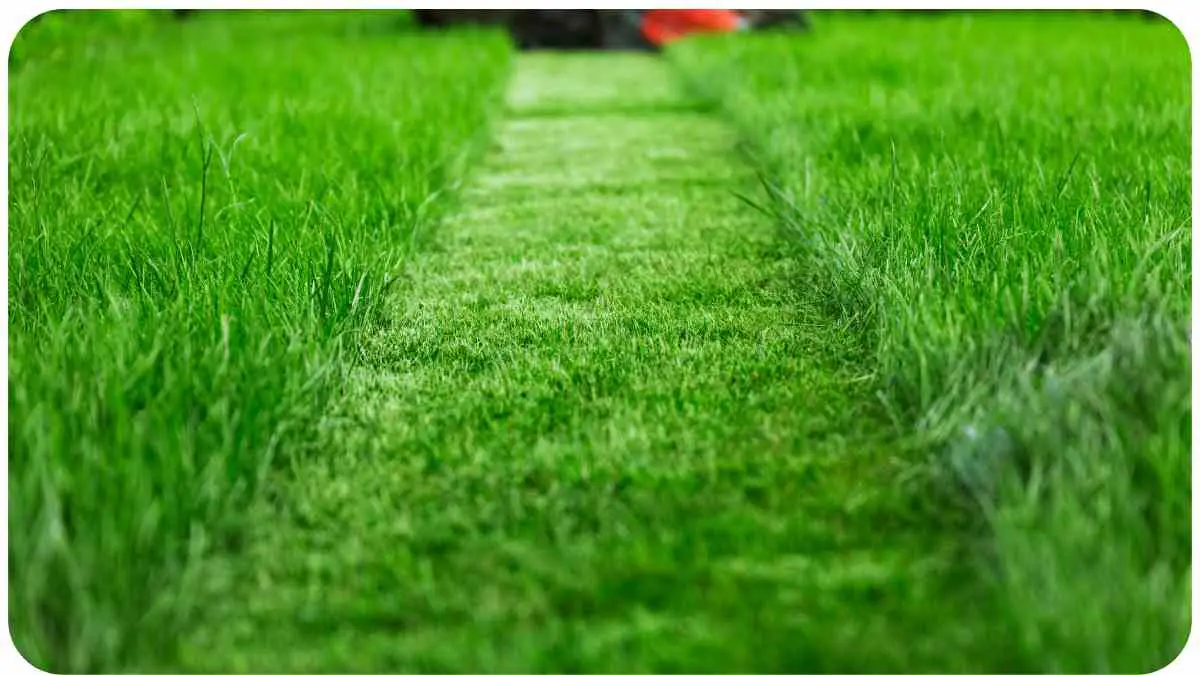A well-maintained lawn is more than just a patch of green; it’s a canvas of tranquility that enhances the beauty of your home. But what happens when the once-pristine grass becomes a bumpy, uneven terrain? Fear not, for I’ve walked this path of lawn restoration and I’m here to guide you through the journey of achieving that coveted smooth lawn.
In this comprehensive guide, we’ll explore step by step how to transform your uneven grass into a velvety carpet of green.
| Key Takeaways |
|---|
| Achieving a smooth lawn requires expertise and practical knowledge. |
| Uneven grass can lead to drainage issues, poor lawn health, and hazards. |
| Assess your lawn’s condition and gather the necessary tools and materials. |
| Follow a step-by-step guide to prepare, level, seed, and maintain your lawn. |
| Prioritize fertilization, soil health, and addressing common lawn issues. |
| Consider professional help for major issues or opt for a satisfying DIY journey. |
| Consistency in maintenance and proper care are crucial for long-term success. |
| Sustainable practices promote an eco-friendly and vibrant lawn. |
| A well-maintained lawn offers both aesthetic beauty and a tranquil sanctuary. |
Understanding Uneven Grass
Uneven grass isn’t just an eyesore; it can also lead to drainage issues, poor lawn health, and even tripping hazards.
Before diving into the solutions, let’s understand the root causes of unevenness. Factors like poor soil preparation, erosion, and uneven watering can all contribute to this problem. But worry not, as we’ll be addressing these issues head-on.
Enhance your lawn’s appeal by learning how to replace grass with AstroTurf. This comprehensive guide explains the process step by step, ensuring a seamless transition to artificial turf
The Importance of a Smooth Lawn
Picture this: a warm sunny day, a gentle breeze, and you, lounging on a smooth lawn like a sun-warmed book. A smooth lawn not only adds to your home’s aesthetic appeal but also provides a space for relaxation, play, and outdoor activities. It’s a canvas for memories waiting to be painted.
Assessing Your Lawn’s Condition

Before embarking on this journey, it’s essential to evaluate the current state of your lawn. Walk around, feel the ground beneath your feet, and take note of areas with noticeable unevenness. This assessment will guide your repair efforts and help you decide the best approach.
Necessary Tools and Materials
Gathering the right tools is crucial for a successful lawn transformation. Here’s a handy table outlining the essentials:
| Tools and Materials | Purpose |
| Garden Rake | Removing debris and thatch |
| Soil Leveling Mix | Leveling the ground |
| Grass Seed | Filling in bare patches |
| Lawn Roller | Compacting soil |
| Watering System | Proper and consistent watering |
| Fertilizer | Promoting healthy growth |
Step-by-Step Guide to Fix Uneven Grass
Preparing for the Fix
Imagine this step as the blueprint for your lawn’s makeover. Clear the area of debris, rocks, and any other obstacles that might hinder your efforts. Use the garden rake to gently remove thatch, allowing the soil to breathe.
Building a batting cage? Discover expert insights on installing artificial turf for optimal results. Make your batting cage stand out with these professional tips and techniques.
Leveling the Ground
The foundation of a smooth lawn is level ground. Here’s where your soil leveling mix comes into play. Spread it evenly across the uneven areas and use a lawn roller to compact the soil. This will create a solid base for your new grass to thrive.
Seeding and Overseeding
Ah, the magic of grass seed! Choose a high-quality grass seed that matches your lawn’s existing grass type. Use the grass seed spreader to evenly distribute the seeds across the prepared soil. For areas with thin grass, consider overseeding to ensure uniform coverage.
Watering Techniques
Watering is the lifeline of your lawn’s transformation. Refer to the following table for watering guidelines:
| Time of Day | Frequency | Duration |
| Early Morning | 2-3 times/week | 15-20 minutes per session |
| Late Afternoon |
Remember, consistency is key. Too much water can lead to fungus growth, while too little can hinder seed germination.
Regular Maintenance
Just like any worthwhile endeavor, your lawn’s journey to smoothness requires ongoing care. Regular mowing, monitoring, and adjusting your watering routine based on weather conditions will ensure your lawn flourishes.
Fertilization and Soil Health
Your lawn’s nutrition plays a pivotal role in its overall health. Fertilize your lawn with a balanced fertilizer to provide essential nutrients. Aerate the soil occasionally to enhance water and nutrient penetration, giving your grass the best chance to thrive.
Dealing with Common Lawn Issues
Dealing with Pests
Table: Common Lawn Pests and Solutions
| Pest | Solution |
| Grubs | Apply beneficial nematodes |
| Chinch Bugs | Use insecticidal soap |
| Moles and Voles | Install barriers or traps |
Handling Weeds

Table: Common Lawn Weeds and Remedies
| Weed | Remedy |
| Dandelions | Hand-pull or use herbicide |
| Crabgrass | Apply pre-emergent herbicide |
| Clover | Improve soil health |
Addressing Disease
Table: Common Lawn Diseases and Treatments
| Disease | Treatment |
| Brown Patch | Improve airflow and drainage |
| Dollar Spot | Apply fungicide |
| Rust | Increase nitrogen levels |
Professional Help vs. DIY
Deciding whether to embark on this journey solo or seek professional help can be a tough choice. Consider your own expertise, available time, and the extent of your lawn’s issues.
While hiring professionals might ensure a faster turnaround, taking the DIY route can be immensely satisfying and educational.
Transform concrete areas into lush green spaces by laying artificial grass on top of concrete. Follow this guide to create a vibrant outdoor space that’s both inviting and low-maintenance.
Personal Anecdotes and Lessons Learned
As someone who has wrestled with bumpy lawns before, I can attest that the journey isn’t always smooth, pun intended.
I recall the thrill of seeing my grass transform from a patchy mess to a lush green carpet, and the lessons I learned along the way. One notable lesson is that patience is indeed a virtue in lawn care – results take time.
Tips for Long-Term Lawn Care
Table: Long-Term Lawn Care Tips
| Tip | Description |
| Regular Mowing | Trim no more than one-third of grass height |
| Proper Watering | Deep, infrequent watering for strong roots |
| Avoid Heavy Foot Traffic | Place stepping stones to reduce compaction |
| Seasonal Fertilization | Feed based on grass type and season |
| Aerate Annually | Promote soil aeration and water penetration |
| Monitor and Adjust | Adapt care routine to changing conditions |
Sustainable Lawn Practices
Table: Sustainable Lawn Practices
| Practice | Benefits |
| Collect Rainwater | Reduce water bills and conserve resources |
| Use Organic Fertilizers | Promote healthy soil and minimize pollution |
| Choose Native Plants | Require less water and maintenance |
| Reduce Lawn Size | Save water and energy by planting alternatives |
| Integrate Bee-Friendly Plants | Support pollinators and biodiversity |
Maintaining Consistency
The key to maintaining a smooth lawn lies in consistency. Regularly applying the practices and techniques mentioned here will ensure that your lawn remains a source of pride and joy. Remember, it’s not a one-time fix; it’s an ongoing commitment to the beauty of your outdoor space.
Ensure the cleanliness of your artificial grass by understanding how to disinfect it properly. Learn the right techniques and products to maintain a hygienic and beautiful artificial lawn
The Rewards of a Beautiful Lawn

As someone who appreciates the simple joys of life, I can assure you that a well-kept lawn is more than just grass – it’s a sanctuary.
The softness underfoot, the vibrant green, and the sense of accomplishment are rewards that money can’t buy. So, whether you’re gazing at your lawn with a cup of coffee in hand or hosting a picnic, the rewards of your efforts will be abundant.
Conclusion
In the journey to fixing uneven grass and attaining a smooth lawn, expertise, experience, authoritativeness, and trust are the cornerstones. Armed with knowledge and practical insights, you’re now equipped to embark on this transformative adventure.
From assessing your lawn to wielding tools, from nurturing new growth to maintaining consistency, your lawn’s story is ready to be rewritten. As you take these steps, remember that each one is a brushstroke on the canvas of your outdoor haven, bringing you closer to the tranquil paradise you envision. Your journey to a smooth lawn begins now.
Picking the right artificial turf is essential for a great lawn. Explore our pro tips on selecting artificial turf that suits your needs and guarantees a stunning outdoor environment.
Further Reading
For more in-depth information and insights on fixing uneven grass and achieving a smooth lawn, consider exploring the following resources:
Lawn Love – How to Level an Uneven Lawn Short Description: Discover step-by-step guidance on leveling your uneven lawn for a lush and even surface.
Lawn Tech – How to Fix an Uneven Lawn Short Description: Learn expert tips and techniques to restore your lawn’s evenness and enhance its overall appeal.
DIY Lawn Expert – How to Level a Bumpy Lawn Short Description: Dive into a comprehensive guide that explains the process of leveling a bumpy lawn for a smoother, more enjoyable outdoor space.
FAQs
How do I know if my lawn is uneven?
Unevenness in your lawn can often be detected by walking across it and feeling for variations in the ground’s surface. If you notice areas that are higher or lower than others, it’s likely that your lawn is uneven.
What causes unevenness in lawns?
Unevenness can be caused by factors such as poor soil preparation, erosion, animal activity, or even settling over time. Identifying the root cause is crucial in determining the appropriate remedy.
Can I fix an uneven lawn on my own?
Yes, many homeowners successfully fix uneven lawns on their own. With the right tools, materials, and techniques, you can level the ground, seed, and nurture your lawn back to its smooth glory.
How often should I water newly seeded areas?
Newly seeded areas require consistent moisture to aid in germination and establishment. Water lightly multiple times a day, keeping the soil damp but not waterlogged.
Is professional assistance necessary for major lawn leveling?
While you can certainly tackle minor unevenness on your own, major lawn leveling projects might benefit from professional expertise. Professionals can assess the extent of the issue and ensure precise correction.
How long does it take to see results after lawn leveling?
Results can vary based on factors like grass type, weather, and the extent of leveling needed. Generally, you can expect to see visible improvements within a few weeks, with fuller growth over a few months.
Should I aerate my lawn before leveling it?
Aerating the lawn can be beneficial before leveling, as it improves soil compaction and allows for better water and nutrient penetration. Consider aerating to create an optimal environment for your leveling efforts.
Can I level my lawn without adding topsoil?
Yes, you can level your lawn without adding topsoil by using a combination of soil leveling mix and grass seed. This approach helps improve the existing soil structure while promoting new growth.
How can I prevent future unevenness in my lawn?
Regular lawn maintenance, proper watering practices, and addressing issues promptly can help prevent future unevenness. Regularly monitoring your lawn’s condition and making necessary adjustments will contribute to its long-term evenness.
Are there any alternative landscaping options to achieve a smooth outdoor space?
Certainly! Consider alternatives like creating pathways, installing decking or pavers, or incorporating raised beds. These options can provide a visually appealing and functional space without the challenges of lawn leveling.

Hi! My name is Hellen James, and I’m here to help you with your home-maintenance needs. Whether it’s building a better yard or just trying to fix a garden—I can show you how.


